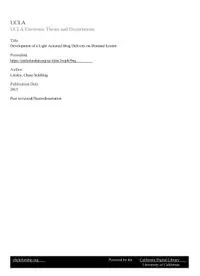
Development of a Light Actuated Drug Delivery-on-Demand System PDF
Preview Development of a Light Actuated Drug Delivery-on-Demand System
UCLA UCLA Electronic Theses and Dissertations Title Development of a Light Actuated Drug Delivery-on-Demand System Permalink https://escholarship.org/uc/item/1wg4c9nq Author Linsley, Chase Schilling Publication Date 2015 Peer reviewed|Thesis/dissertation eScholarship.org Powered by the California Digital Library University of California UNIVERSITY OF CALIFORNIA Los Angeles Development of a Light Actuated Drug Delivery-on-Demand System A dissertation submitted in partial satisfaction of the requirements for the degree Doctor of Philosophy in Biomedical Engineering by Chase Schilling Linsley 2015 © Copyright by Chase Schilling Linsley 2015 ABSTRACT OF THE DISSERTATION Development of a Light Actuated Drug Delivery-on-Demand System by Chase Schilling Linsley Doctor of Philosophy in Biomedical Engineering University of California, Los Angeles, 2015 Professor Benjamin M. Wu, Chair The need for temporal-spatial control over the release of biologically active molecules has motivated efforts to engineer novel drug delivery-on-demand strategies actuated via light irradiation. Many systems, however, have been limited to in vitro proof-of-concept due to biocompatibility issues with the photo-responsive moieties or the light wavelength, intensity and duration. To overcome these limitations, the objective of this dissertation was to design a light actuated drug delivery-on-demand strategy that uses biocompatible chromophores and safe wavelengths of light, thereby advancing the clinical prospects of light actuated drug delivery-on- demand systems. This was achieved by 1) characterizing the photothermal response of biocompatible visible light and near infrared-responsive chromophores, and demonstrating the feasibility and functionality of the light actuated on-demand drug delivery system in vitro; and 2) designing a modular drug delivery-on-demand system that could control the release of biologically active molecules over an extended period of time. ii Three biocompatible chromophores – cardiogreen, methylene blue, and riboflavin – were identified and demonstrated significant photothermal response upon exposure to near infrared and visible light, and the amount of temperature change was dependent upon light intensity, wavelength as well as chromophore concentration. As a proof-of-concept, pulsatile release of a model protein from a thermally responsive delivery vehicle fabricated from poly (N- isopropylacrylamide) was achieved over four days by loading the delivery vehicle with cardiogreen and irradiating with near infrared light. To extend the useful lifetime of the light actuated drug delivery-on-demand system, a modular, reservoir-valve system was designed. Using poly (ethylene glycol) as a reservoir for model small molecule drugs combined with a poly (N-isopropylacrylamide) valve spiked with chromophore-loaded liposomes, pulsatile release was achieved over seven days upon light irradiation. Ultimately, this drug delivery strategy has potential for clinical applications that require explicit control over the presentation of biologically active molecules. Further research into the design and fabrication of novel biocompatible thermally responsive delivery vehicles will aid in the advancement of the light actuated drug delivery-on-demand strategy described here. iii The dissertation of Chase Schilling Linsley is approved. James C.Y. Dunn Adrienne G. Lavine Min Lee Benjamin M. Wu, Committee Chair University of California, Los Angeles 2015 iv DEDICATION To Dad, Mom, Chelsea and Grandma too! v TABLE OF CONTENTS Abstract of the Dissertation ……………………………………………………………………... ii Committee Page ………………………………………………………………………………… iv Dedication ……………………………………………………………………………………….. v List of Figures …………………………………………………………………………………... ix List of Tables …………………………………………………………………………………... xv Acknowledgments …………………………………………………………………………….. xvi Vita …………………………………………………………………………………………… xvii Chapter 1: Introduction ………………………………………………………………………….. 1 1.1 Background ………………………………………………………………………….. 1 1.2 Controlled Release Technology ……………………………………………………... 2 1.3 Biomedical Applications Requiring Delivery-On-Demand …………………………. 5 1.4 Delivery-On-Demand Systems ……………………………………………………… 7 1.5 Dissertation Objective and Specific Aims …………………………………………... 9 1.6 Tables ………………………………………………………………………………. 11 1.7 References ………………………………………………………………………….. 14 Chapter 2: Visible Light and Near Infrared-Responsive Chromophores for Drug Delivery-on- Demand Applications …………………………………...……………………………………… 23 2.1 Abstract …………………………………………………………………………….. 23 2.2 Introduction ………………………………………………………………………… 23 2.3 Materials and Methods ……………………………………………………………... 26 2.3.1 Chromophores 2.3.2 Chromophore-Dependent Temperature Change vi 2.3.3 Photothermal-Triggered Release from Thermally Responsive NiPAAm 2.4 Results ……………………………………………………………………………… 29 2.4.1 Concentration- and Power-Dependent Temperature Changes 2.4.2 Wavelength-Dependent Temperature Change 2.4.3 Chromophore Lifetime 2.4.4 Rate of Chromophore-Dependent Temperature Change 2.4.5 Photothermal-Triggered Release from Thermally Responsive NiPAAm 2.5 Discussion ………………………………………………………………………….. 35 2.6 Conclusion …………………………………………………………………………. 41 2.7 Figures ……………………………………………………………………………… 43 2.8 Tables ………………………………………………………………………………. 54 2.9 References ………………………………………………………………………….. 58 Chapter 3: Light Actuated Release from a Modular Drug Delivery-on-Demand System ……... 66 3.1 Abstract …………………………………………………………………………….. 66 3.2 Introduction ………………………………………………………………………… 66 3.3 Materials and Methods ……………………………………………………………... 69 3.3.1 Chromophores and Model Small Molecule Drugs 3.3.2 Thermally Responsive NiPAAm Hydrogel Synthesis and Mass Swelling Ratio 3.3.3 Polymeric Reservoir Synthesis and Drug Loading 3.3.4 Chromophore-loaded Liposome Synthesis 3.3.5 Measuring Drug Release 3.4 Results ……………………………………………………………………………… 73 vii 3.4.1 Mesh Size of NiPAAm Hydrogels 3.4.2 Drug Diffusion From Polymeric Reservoirs and Through NiPAAm Hydrogels 3.4.3 Light Actuated Release From Modular Drug Delivery System 3.5 Discussion ………………………………………………………………………….. 77 3.6 Conclusion …………………………………………………………………………. 84 3.7 Figures ……………………………………………………………………………... 85 3.8 Tables …………………………………………………………………………….... 89 3.9 References …………………………………………………………………………. 91 Chapter 4: Conclusions and Future Directions ……………………………………………….... 96 4.1 Engineering Biocompatible Photo-Responsive Materials …………………………. 97 4.2 Designing a Low Power, Multiple-Beam Near Infrared Source …………………… 99 4.3 In Vivo Validation: Safety and Efficacy ………...………………………………... 101 4.4 Concluding Remarks ……………………………………………………………… 104 4.5 Figures …………………………………………………………………………….. 106 4.6 References ………………………………………………………………………… 111 viii
